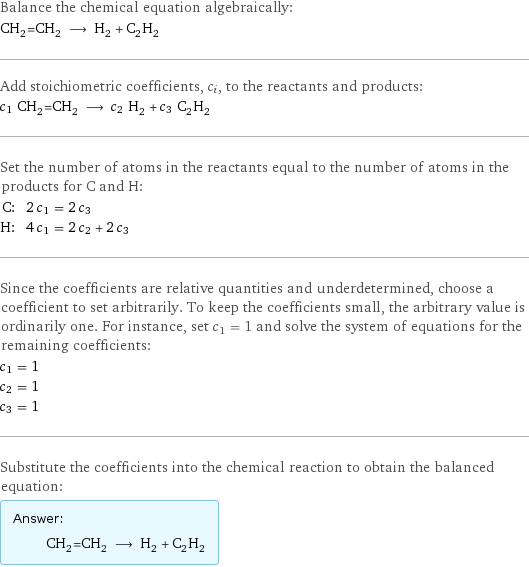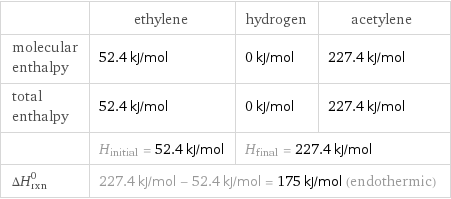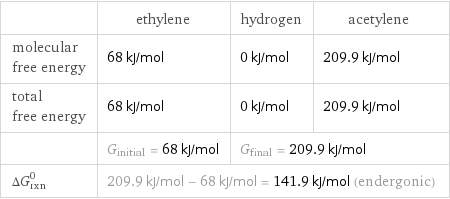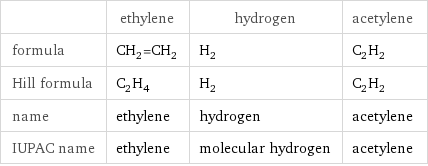Input interpretation

CH_2=CH_2 ethylene ⟶ H_2 hydrogen + C_2H_2 acetylene
Balanced equation

Balance the chemical equation algebraically: CH_2=CH_2 ⟶ H_2 + C_2H_2 Add stoichiometric coefficients, c_i, to the reactants and products: c_1 CH_2=CH_2 ⟶ c_2 H_2 + c_3 C_2H_2 Set the number of atoms in the reactants equal to the number of atoms in the products for C and H: C: | 2 c_1 = 2 c_3 H: | 4 c_1 = 2 c_2 + 2 c_3 Since the coefficients are relative quantities and underdetermined, choose a coefficient to set arbitrarily. To keep the coefficients small, the arbitrary value is ordinarily one. For instance, set c_1 = 1 and solve the system of equations for the remaining coefficients: c_1 = 1 c_2 = 1 c_3 = 1 Substitute the coefficients into the chemical reaction to obtain the balanced equation: Answer: | | CH_2=CH_2 ⟶ H_2 + C_2H_2
Structures

⟶ +
Names

ethylene ⟶ hydrogen + acetylene
Reaction thermodynamics
Enthalpy

| ethylene | hydrogen | acetylene molecular enthalpy | 52.4 kJ/mol | 0 kJ/mol | 227.4 kJ/mol total enthalpy | 52.4 kJ/mol | 0 kJ/mol | 227.4 kJ/mol | H_initial = 52.4 kJ/mol | H_final = 227.4 kJ/mol | ΔH_rxn^0 | 227.4 kJ/mol - 52.4 kJ/mol = 175 kJ/mol (endothermic) | |
Gibbs free energy

| ethylene | hydrogen | acetylene molecular free energy | 68 kJ/mol | 0 kJ/mol | 209.9 kJ/mol total free energy | 68 kJ/mol | 0 kJ/mol | 209.9 kJ/mol | G_initial = 68 kJ/mol | G_final = 209.9 kJ/mol | ΔG_rxn^0 | 209.9 kJ/mol - 68 kJ/mol = 141.9 kJ/mol (endergonic) | |
Entropy

| ethylene | hydrogen | acetylene molecular entropy | 219 J/(mol K) | 115 J/(mol K) | 201 J/(mol K) total entropy | 219 J/(mol K) | 115 J/(mol K) | 201 J/(mol K) | S_initial = 219 J/(mol K) | S_final = 316 J/(mol K) | ΔS_rxn^0 | 316 J/(mol K) - 219 J/(mol K) = 97 J/(mol K) (endoentropic) | |
Equilibrium constant
![Construct the equilibrium constant, K, expression for: CH_2=CH_2 ⟶ H_2 + C_2H_2 Plan: • Balance the chemical equation. • Determine the stoichiometric numbers. • Assemble the activity expression for each chemical species. • Use the activity expressions to build the equilibrium constant expression. Write the balanced chemical equation: CH_2=CH_2 ⟶ H_2 + C_2H_2 Assign stoichiometric numbers, ν_i, using the stoichiometric coefficients, c_i, from the balanced chemical equation in the following manner: ν_i = -c_i for reactants and ν_i = c_i for products: chemical species | c_i | ν_i CH_2=CH_2 | 1 | -1 H_2 | 1 | 1 C_2H_2 | 1 | 1 Assemble the activity expressions accounting for the state of matter and ν_i: chemical species | c_i | ν_i | activity expression CH_2=CH_2 | 1 | -1 | ([CH2=CH2])^(-1) H_2 | 1 | 1 | [H2] C_2H_2 | 1 | 1 | [C2H2] The equilibrium constant symbol in the concentration basis is: K_c Mulitply the activity expressions to arrive at the K_c expression: Answer: | | K_c = ([CH2=CH2])^(-1) [H2] [C2H2] = ([H2] [C2H2])/([CH2=CH2])](../image_source/68f4cf78be12079362d378b4ebf27255.png)
Construct the equilibrium constant, K, expression for: CH_2=CH_2 ⟶ H_2 + C_2H_2 Plan: • Balance the chemical equation. • Determine the stoichiometric numbers. • Assemble the activity expression for each chemical species. • Use the activity expressions to build the equilibrium constant expression. Write the balanced chemical equation: CH_2=CH_2 ⟶ H_2 + C_2H_2 Assign stoichiometric numbers, ν_i, using the stoichiometric coefficients, c_i, from the balanced chemical equation in the following manner: ν_i = -c_i for reactants and ν_i = c_i for products: chemical species | c_i | ν_i CH_2=CH_2 | 1 | -1 H_2 | 1 | 1 C_2H_2 | 1 | 1 Assemble the activity expressions accounting for the state of matter and ν_i: chemical species | c_i | ν_i | activity expression CH_2=CH_2 | 1 | -1 | ([CH2=CH2])^(-1) H_2 | 1 | 1 | [H2] C_2H_2 | 1 | 1 | [C2H2] The equilibrium constant symbol in the concentration basis is: K_c Mulitply the activity expressions to arrive at the K_c expression: Answer: | | K_c = ([CH2=CH2])^(-1) [H2] [C2H2] = ([H2] [C2H2])/([CH2=CH2])
Rate of reaction
![Construct the rate of reaction expression for: CH_2=CH_2 ⟶ H_2 + C_2H_2 Plan: • Balance the chemical equation. • Determine the stoichiometric numbers. • Assemble the rate term for each chemical species. • Write the rate of reaction expression. Write the balanced chemical equation: CH_2=CH_2 ⟶ H_2 + C_2H_2 Assign stoichiometric numbers, ν_i, using the stoichiometric coefficients, c_i, from the balanced chemical equation in the following manner: ν_i = -c_i for reactants and ν_i = c_i for products: chemical species | c_i | ν_i CH_2=CH_2 | 1 | -1 H_2 | 1 | 1 C_2H_2 | 1 | 1 The rate term for each chemical species, B_i, is 1/ν_i(Δ[B_i])/(Δt) where [B_i] is the amount concentration and t is time: chemical species | c_i | ν_i | rate term CH_2=CH_2 | 1 | -1 | -(Δ[CH2=CH2])/(Δt) H_2 | 1 | 1 | (Δ[H2])/(Δt) C_2H_2 | 1 | 1 | (Δ[C2H2])/(Δt) (for infinitesimal rate of change, replace Δ with d) Set the rate terms equal to each other to arrive at the rate expression: Answer: | | rate = -(Δ[CH2=CH2])/(Δt) = (Δ[H2])/(Δt) = (Δ[C2H2])/(Δt) (assuming constant volume and no accumulation of intermediates or side products)](../image_source/7f6d2e918be76d0a7041cb59c38573d0.png)
Construct the rate of reaction expression for: CH_2=CH_2 ⟶ H_2 + C_2H_2 Plan: • Balance the chemical equation. • Determine the stoichiometric numbers. • Assemble the rate term for each chemical species. • Write the rate of reaction expression. Write the balanced chemical equation: CH_2=CH_2 ⟶ H_2 + C_2H_2 Assign stoichiometric numbers, ν_i, using the stoichiometric coefficients, c_i, from the balanced chemical equation in the following manner: ν_i = -c_i for reactants and ν_i = c_i for products: chemical species | c_i | ν_i CH_2=CH_2 | 1 | -1 H_2 | 1 | 1 C_2H_2 | 1 | 1 The rate term for each chemical species, B_i, is 1/ν_i(Δ[B_i])/(Δt) where [B_i] is the amount concentration and t is time: chemical species | c_i | ν_i | rate term CH_2=CH_2 | 1 | -1 | -(Δ[CH2=CH2])/(Δt) H_2 | 1 | 1 | (Δ[H2])/(Δt) C_2H_2 | 1 | 1 | (Δ[C2H2])/(Δt) (for infinitesimal rate of change, replace Δ with d) Set the rate terms equal to each other to arrive at the rate expression: Answer: | | rate = -(Δ[CH2=CH2])/(Δt) = (Δ[H2])/(Δt) = (Δ[C2H2])/(Δt) (assuming constant volume and no accumulation of intermediates or side products)
Chemical names and formulas

| ethylene | hydrogen | acetylene formula | CH_2=CH_2 | H_2 | C_2H_2 Hill formula | C_2H_4 | H_2 | C_2H_2 name | ethylene | hydrogen | acetylene IUPAC name | ethylene | molecular hydrogen | acetylene
Substance properties

| ethylene | hydrogen | acetylene molar mass | 28.054 g/mol | 2.016 g/mol | 26.038 g/mol phase | gas (at STP) | gas (at STP) | gas (at STP) melting point | -169 °C | -259.2 °C | -81 °C boiling point | -104 °C | -252.8 °C | -75 °C density | 1.153 g/cm^3 (at 25 °C) | 8.99×10^-5 g/cm^3 (at 0 °C) | 0.618 g/cm^3 (at -55 °C) solubility in water | insoluble | | surface tension | 0.0181 N/m | | 0.01431 N/m dynamic viscosity | 1.034×10^-5 Pa s (at 25 °C) | 8.9×10^-6 Pa s (at 25 °C) | odor | | odorless |
Units
